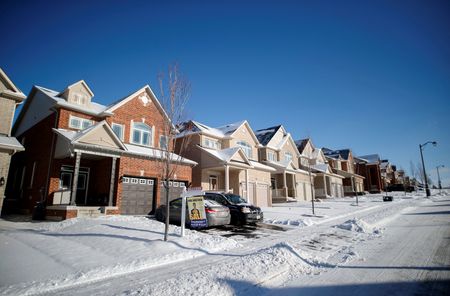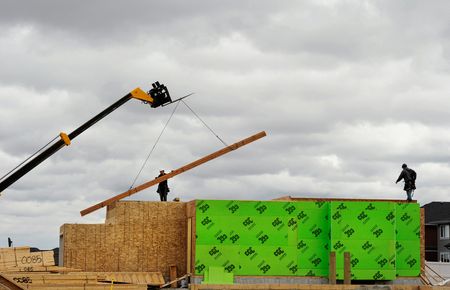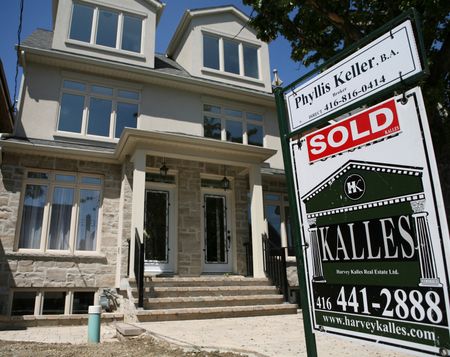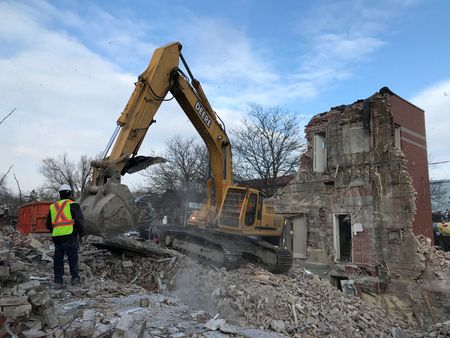




By Julie Gordon and Nichola Saminather
OTTAWA (Reuters) – Canada has an ambitious plan to double the pace of homebuilding within a decade but the first big challenge is finding enough skilled workers, as the country grapples with the tightest labor market on record and with construction already at a multi-year high.
Building more homes is a key peg of the C$9.5 billion ($7.5 billion) in housing spending outlined by Prime Minister Justin Trudeau’s Liberal government in their budget on Thursday.
The average selling price of a Canadian home has surged more than 50% in the last two years, driven by record low interest rates and tight supply. Construction has failed to keep pace with immigration-driven population growth.
But the plan to build hundreds of thousands of new homes runs counter the reality that home building is generally the purview of municipal and provincial governments, leaving the federal government little role beyond handing out money.
“It’s very ambitious. I would say it’s going to be equally challenging to pull it off, simply because the construction sector is already more or less operating at full capacity,” said Robert Kavcic, senior economist at BMO Economics.
“And we are already building a record number of homes in this country.”
Canada has the lowest number of housing units per 1,000 residents of any Group of Seven nation, and that has been on the decline due to population growth, Bank of Nova Scotia economists said https://www.scotiabank.com/ca/en/about/economics/economics-publications/post.other-publications.housing.housing-note.housing-note–may-12-2021-.html in a report last year.
There are nearly 300,000 units under construction across Canada, compared with about 240,000 just two years ago, government data https://www.cmhc-schl.gc.ca/en/professionals/housing-markets-data-and-research/housing-data/data-tables/housing-market-data/housing-starts-completions-units-under-construction shows.
Canada is building “a lot and not enough,” said William Strange, professor of economic analysis and policy at the University of Toronto. “We’ve taken decades getting into this situation and we’re not going to get out of it in six months.”
Canada has added more than 100,000 construction jobs in the last four months alone, a historic run of increases for the sector. Overall jobless rate fell to a record 5.3% in March.
“Just the sheer volume of work that exists within the industry (creates) a lot of pressure on the various trades,” said Jim Ritchie, chief operating officer of Tridel, which develops condominiums in the Toronto area.
“So there’s a lot of demand for that workforce.”
Canada’s immigration program could be a double-edged sword, as it brings in more skilled workers to replace a fast-retiring workforce, but also fuels housing demand. There is also a mismatch between the workers Canada is currently targeting and those it needs.
“Right now, our immigration policies are more geared towards attracting white collar labor than blue collar labor,” said Mike Moffatt, senior director of policy and innovation at the Smart Prosperity Institute.
Construction costs rose nearly 10% in 2021 and are set to climb again, driven by higher labor and materials costs, adding to the near-term challenges, said Ritchie of Tridel.
Municipal and provincial approval delays, which the federal government hopes to address with a C$4 billion “Housing Accelerator Fund,” and the availability of land add to the hurdles.
“There a whole bunch of levers that need to be pulled and increasing labor supply… is one of them,” said Justin Sherwood, a spokesperson for the Building Industry and Land Development Association in the Toronto area.
Still, Canada’s Finance Minister Chrystia Freeland was undeterred.
“We are going to do everything we say we’re going to do,” she told reporters on Thursday when asked about the challenge of meeting the plan.
“A growing population needs a growing housing supply.”
($1 = 1.2588 Canadian dollars)
(Reporting by Julie Gordon in Ottawa and Nichola Saminathar in Toronto; Editing by Nick Zieminski)

